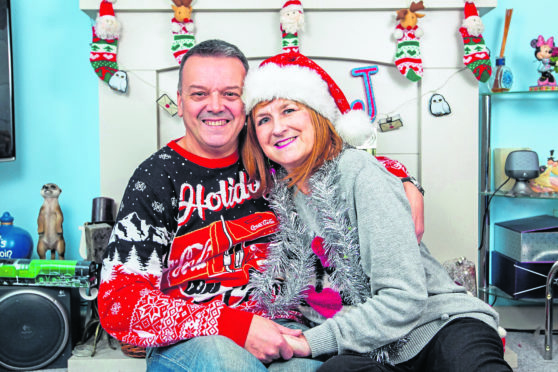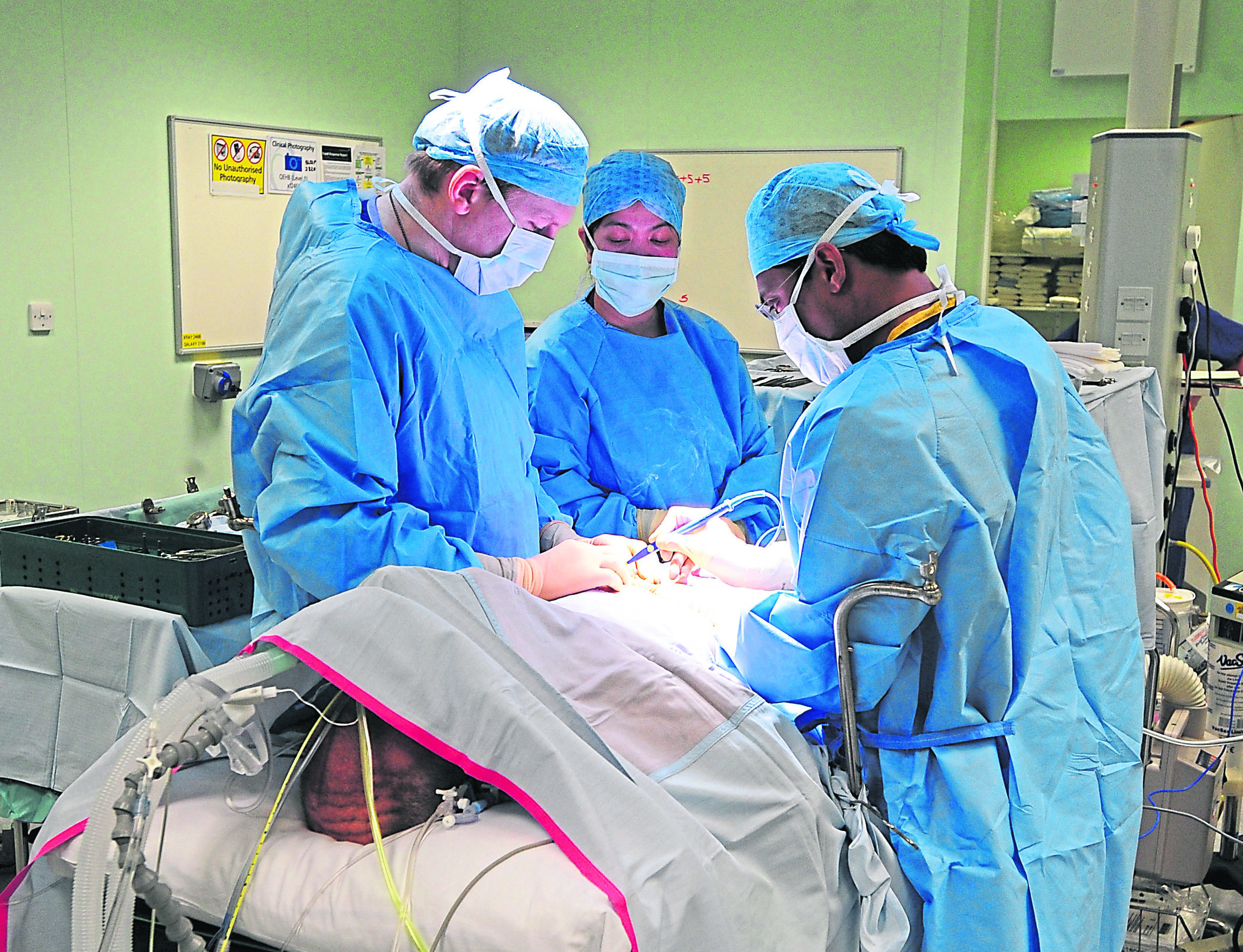
John Cowan doesn’t need to ask what wife Julie would like for Christmas this year be cause he’s already given her the best gift she could ask for – a new lease of life.
This time last year, Julie’s organs were failing, signalling the need for a kidney transplant but, while he immediately offered one of his, John wasn’t a match.
However, the couple signed up for the UK Living Kidney Sharing Scheme, a pool of living donors willing to donate their organs to a stranger in the hope that their loved one can receive.
And recently they underwent the surgery that will change Julie’s life forever.
Last week, as the pair continue to recover at home in East Kilbride, they’re looking forward to celebrating what will be an extra special Christmas.
“It’s just incredible, an absolute miracle,” Julie, 57, said.
“I can’t thank John enough. He’s given me the greatest gift I could ever hope for.”
Julie’s kidney problems first came to light in 2000, before she met John.
“I had really bad pains, which were a bit of a mystery. I remember at one point being in the care of five different doctors,” she said.
“They thought it was gallstones – but a few months later I went for an ultrasound on my kidneys – and the consultant noticed cysts on them.
“He said I could live to 40 – or I could live to 90.
“There were two different types of cystic kidney disease and he didn’t know which one it was, but one of them had a bleak prognosis.
“I was only 38 at the time, and on my own with a seven-year-old son.
“I felt like my life flashed before my eyes. All I could think was who was going to look after my son if I died. It was devastating.”
Soon after, Julie was diagnosed with polycystic kidney disease, a condition where cysts develop in the liver.
It had the most promising outlook of the two.
The condition is rare, with fewer than 20,000 cases diagnosed in the UK every year.
Although there is no cure, it can be treated with medication, dialysis and, where the kidneys are failing, transplant surgery.
The primary school teacher said: “Thankfully I still had 50% kidney function which was good, so it didn’t affect me too much in the early days.
“But last year I started to get really tired and had swelling in my ankles and feet and my face.
“I was so lethargic, I had to give up badminton, which I have played since I was 11. I didn’t have enough energy.”
Last Christmas, Julie’s kidney function fell to about 12%, meaning she was on the borderline for dialysis, and would need to start thinking about a transplant.
Julie’s son David, 28, offered one of his organs, but she refused.
“He’s still so young and I wanted him to have a life,” Julie said. “It was a lovely gesture, but I just couldn’t.”
Husband John also volunteered one of his kidneys.
“It was a no-brainer,” John, 55, said.
“I didn’t even think about it. It was just an automatic response.
“I would do anything for Julie, and give anything to see her get better. If that meant giving her a kidney, that’s what I was going to do.”
Julie was flattered, but initially turned down the gesture. “It was just too much of a sacrifice,” Julie, said.
“I would give my two kidneys or my heart to any family member in the same position if I could, but I found it hard to accept such a huge thing.
“It was too risky. I couldn’t face the fact that it might have implications on John’s health.”
Julie pleaded with her husband to reconsider, but John’s mind was made up.
He was tested – but sadly wasn’t a suitable match.
However, when consultants suggested signing up for the UK Living Kidney Sharing Scheme – where living donors can donate a kidney in the hope of being paired with other donors and securing a match for a relative – he jumped at the chance.
The aircraft engineer said; “It was the next best thing to not being a match, so I thought ‘That’s the way to go’.
“It was like a get-out-of-jail-free card! When Julie saw that me giving up my kidney could benefit someone else, as well as her, she eventually agreed.
“It just blew my mind that something like this was possible.”
Just a few months ago, doctors matched Julie and John with another two couples on the shared scheme, creating a three-way swap.
“We went to see the transplant co-ordinator and two months later we got a call to say there was a match with two other pairs.
“We couldn’t believe it. We just looked at each other and shed a tear.
“I was so surprised because I honestly thought we would be a year down the line and I’d be facing the rest of my life on dialysis,” Julie said.
The surgery went ahead in October at the Queen Elizabeth University Hospital, with John having his kidney removed and Julie receiving her new kidney on the same day, just hours apart.
Aside from a brief setback with John contracting a post-surgery infection and having to go back into hospital to be treated for sepsis, the pair, who have been married for seven years, are recovering well – and looking forward to celebrating this Christmas.
“My kidney function is up to 88% now,” Julie said. “In fact, the doctors said its as if I have a pair of working kidneys.
“I’m starting to feel my energy coming back now – and I’m progressing every day.
“And John is making a good recovery too.
“We’re looking forward to Christmas now because we have so much to celebrate.”
John added: “I’m so pleased everything went well.
“I must admit, I was a little apprehensive when the surgeon took a pen and drew an arrow on my side, but I’ve come out feeling great, and with just a little scar. It was nothing really.
“And it was worth it to get my old Julie back.
“I just look at her now and I can see the Julie that I first met.
“It’s been amazing to see her getting better.
“We were so well looked after before surgery, during and after and we can’t thank the team at the hospital enough. They were amazing.”
Julie added: “It’s all very surreal, but a real dream come true.
“I just want to thank all my family for looking after us. They have been amazing.
“And John, of course.
“He has given me the most extra-special Christmas present I could ever receive, as well as a fantastic Christmas to look forward to, and many more to come.”
And she joked: “John has given me his kidney – and his heart – but I’ll still be hoping for a wee something under the tree!”
To find out more about living donation, go to livingdonationscotland.org
800 donors in past 10 years give gift to transform a life

Over 800 people in Scotland have helped others by donating a kidney in the last decade.
A healthy person can lead a completely normal life with one kidney, and a kidney from a living donor generally offers the best outcomes for patients living with kidney failure who need a transplant.
There are usually two routes to living kidney donation – directed donation where a friend, relative or partner donates to a loved one, or non-directed altruistic donation which involves a person donating to a stranger who is best matched on the waiting list, usually starting a ‘chain’ of transplants.
The UK Living Kidney Sharing Scheme was established to help increase the number of people who can receive transplants from living kidney donors, and the opportunities for patients who wait a long time for a transplant.
Through the scheme, when a donor and recipient already know each other but are not a match, they are paired with another donor and recipient in the same situation who ‘swap’ donors. This can also involve more than two pairs.
The kidney is the most commonly transplanted organ in the UK. A single normal kidney usually provides enough function for an adult, but occasionally two kidneys are transplanted into one patient. Anyone can volunteer to give a kidney, but it must be something they choose to do and feel comfortable doing. There is no upper age limit to being a living kidney donor.

Enjoy the convenience of having The Sunday Post delivered as a digital ePaper straight to your smartphone, tablet or computer.
Subscribe for only £5.49 a month and enjoy all the benefits of the printed paper as a digital replica.
Subscribe